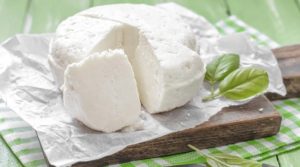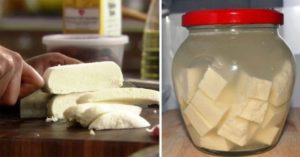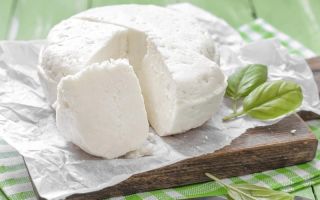Content
- 1 Composition and calorie content of feta cheese
- 2 Useful properties of feta cheese
- 3 For whom cheese is especially useful
- 4 Is it possible to eat feta cheese while losing weight (on a diet)
- 5 At what age children can be given feta cheese
- 6 What can be made from feta cheese and what does it combine with
- 7 The classic recipe for homemade feta cheese
- 8 Harm of feta cheese for the body and contraindications
- 9 How to choose the right feta cheese
- 10 How to store feta cheese at home
- 11 Conclusion
Cheese is a fermented milk product obtained from the milk of goats, sheep, cows. It tastes and looks like cheese, the same white color and consistency. The benefits and harms of feta cheese are facts that have long been known to mankind as the very use of the product.

Composition and calorie content of feta cheese
Brine cheese, unlike other hard varieties, is optimally balanced. Fats are few in comparison with proteins, which determines the benefits of feta cheese for the body.
The preparation of brine cheese does not require heat treatment, which affects the preservation of the useful components of the product.
Cheese does not contain carbohydrates, this allows those who want to lose extra pounds to use the product.
Salted cheese composition:
- organic acid compounds;
- vitamins of group B, A, D, E;
- cholesterol;
- minerals: phosphorus, potassium, magnesium, iron, sulfur.
The benefits and harms of feta cheese for the human body are explained by the variety of constituent components.
Calorie content of feta cheese per 100 grams:
|
Composition |
Dosage |
% of daily value |
|
Protein |
19 g |
26 |
|
Fats |
21 g |
27 |
|
Carbohydrates |
0.6 g |
0 |
|
Calorie content |
265 kcal |
18 |
Useful properties of feta cheese
The most useful is sheep's cheese, despite its high fat content. The product owes its valuable medicinal properties to the specifics of its manufacture.
- Cheese is not subject to heat treatment, the most useful components of the product: minerals, proteins, vitamins are not destroyed under the influence of high temperatures.
- Rich composition of vitamins, minerals: calcium, fluorine, potassium, magnesium; protein and fatty acids make the food a source of essential nutrients.
- The specific processing of milk helps to preserve calcium and make it easily digestible. This product is useful for the child's body, since calcium is necessary for the growth of teeth and bones of the child.
- Brine cheese contains essential protein and fatty acids. They will help to restore strength during heavy loads.
Thus, the benefits of sheep cheese are obvious. The same goes for goat and cow cheeses.
For whom cheese is especially useful
Due to its rich composition, specificity of preparation, the product is useful for almost everyone. Especially some groups of people.
It is impossible to overestimate the benefits of feta cheese for women during menopause and for elderly women, when there is an increased leaching of calcium from the female body.
There is no other product with such a high calcium content, so easily absorbed by the human body. If you take calcium tablets, then it is poorly absorbed, the proportion of the valuable mineral remaining in the body is negligible. Therefore, feta cheese should be included in the daily diet of all women after 40 years.
It is advisable for pregnant women to eat sheep or goat cheese, which is useful for the formation of the skeletal system of the future baby. It's important not to overuse. You can make salted cheese the main ingredient in salads.
A fermented milk product is useful for children when their bones and teeth grow.In order to strengthen the child's body, there is more benefit from goat cheese, since the milk of these animals is hypoallergenic, does not cause allergic reactions, which is important for today's children.
Goat cheese is suitable for young nursing mothers. The value of cheese - the basis of preparation is hypoallergenic raw materials.
Proteins, fatty acids are necessary for people engaged in hard physical labor.
If a salty product is eaten daily:
- improves skin color;
- condition of the nails (they stop exfoliating, breaking);
- teeth regain their original whiteness;
- hair becomes stronger.
Is it possible to eat feta cheese while losing weight (on a diet)
It is difficult to classify the product as a dietary meal.
Those who want to lose weight should reduce or stop their consumption of salted cheese. It contains a lot of fat. For people with active physical activity, brine cheese, rich in protein, is perfect for a daily diet.
Cheese is suitable for the purpose of a protein diet, during the "drying" of the body (bodybuilders, athletes involved in arm wrestling). Sheep, goat curds restore tissue elasticity, promote the growth of muscle cells, muscle tissue.
Less high-calorie feta cheese from cow's milk. Cheese manufacturers produce a fat-free product. Those who are afraid to gain extra pounds can include a low-fat version of pickled cheese in their daily menu.
Before you "go" on a cheese diet, it is advisable to consult a dietitian. He will take into account the individual characteristics of the body, give the necessary recommendations.
At what age children can be given feta cheese
Cheese is one of the favorite foods in almost every family. Young mothers want to know at what age a cheese treat can be added to the children's menu. In order to strengthen the immune system of children, feta cheese is very useful:
- It contains many proteins required for tissue growth.
- There is more calcium than cottage cheese.
- A variety of vitamins: A, B, PP, D, E.
- Contains mineral salts: iron, zinc, phosphorus.
- Fatty acids improve brain function.
Pediatricians do not recommend adding a cheese product to toddlers under one year old. They believe that the digestive system is not fully formed, there are not enough teeth yet, the kidneys of the child will not be able to process the mineral salts contained in the product. Therefore, you can add cheese to a child's diet by 12 months.
They start a little bit, from 6-7 g, bringing this amount to 35 g during the year. In addition, children are given cheese infrequently: in a day or two.
After two years, babies are treated to fermented milk cheeses, including feta cheese.

What can be made from feta cheese and what does it combine with
This product is common among many peoples:
- Bulgarians;
- Serbs;
- Greeks;
- Italians and others.
Pickled cheese is used as the main component of many dishes.
- Cheese is added to many salads.
- It is used for making pate and sauces.
- Bake in slices in the oven. It turns out an amazing appetizer with a spicy taste.
- Add to scrambled eggs or omelet.
- Chicken fillet with feta cheese is a dish worthy of a festive table.
- Sheep feta cheese is a delicious filling for pies.
- Any pizza cheese can replace pickled cheese.
It goes well with many vegetables, especially:
- tomatoes;
- eggplant;
- sweet pepper.

The classic recipe for homemade feta cheese
The basis of real feta cheese is goat's or sheep's milk, but it's almost impossible to get it if you don't actually be a farmer and keep a herd of sheep or goats. Prepare healthy homemade feta cheese, more accessible from cow's milk.
You will need:
- 1.5 liters of fat milk;
- 0.5 tbsp. sour cream;
- 2.5 tbsp. l. lemon juice;
- 1.5 tsp. salt;
- 1.5 tbsp. water.
Cooking.
- Pour milk into a container, place on fire.
- Pour in sour cream, mix thoroughly.
- As soon as the milk begins to curd, add the lemon juice.
- Continue to heat for 1.5-2 minutes.
- Throw the resulting mixture in a colander covered with gauze.
- After draining the skim milk (whey), wrap the cheese, press down on top with oppression and leave for 60 minutes.
- Cut the cheese and place in brine (water + salt). In half an hour, the cheese is ready.
- Store it in brine.
Harm of feta cheese for the body and contraindications
The technology of making brine cheese determines contraindications to its consumption.
It is advisable to limit or exclude the product from the diet for people:
- with chronic diseases of the stomach and intestines;
- cardiovascular insufficiency and hypertension;
- disorders of the nervous system;
- with intolerance to milk protein;
- with increased or decreased acidity of the stomach.
The use of feta cheese for gastritis is strictly prohibited by doctors, since brine cheese can worsen health and promote the formation of ulcers.
It is not forbidden to eat feta cheese with pancreatitis. Doctors advise to feast on it occasionally a little.
For people with a disease such as diabetes, before eating a piece of brine cheese, it is necessary to pour it over with boiling water, then soak it in water for at least half an hour. It is not necessary to completely abandon feta cheese with diabetes.
If there are no health problems or overweight, you can safely include pickled cheese in the diet. But doctors do not advise eating a product that is more than 200 g daily.
How to choose the right feta cheese
In order not to be mistaken, to buy good quality pickled cheese, you need to pay attention to the following points:
- The package must contain brine. In it, the cheese retains its taste and useful properties for a long time. The absence of brine indicates the age of the product or the manufacturer used a preservative.
- Take a close look at the color. Pure white color (slight yellowish tinge may be present). A coating of brown or gray colors informs about the staleness of the product. It is undesirable to buy it.
- There should be no dried rind. If it is, then the product is expired.
- There is no place for preservatives in high-quality brine cheese. You can find out by looking at the composition on the package.
- An important indicator is fat content. If it is not more than 27%, the cheese will be dry and crumble. At 50% and above - the product is soft with a creamy taste.
- Don't forget the release date. Fresh brine cheese is not too salty compared to previously cooked feta cheese.
How to store feta cheese at home
If brine is made at home, store it in the same brine. And if the product is bought in a store, one must remember: feta cheese in an open package remains fresh for 4-5 days, it is stored in brine. If for some reason it is not there, the product is wrapped in aluminum foil, then placed in glass or enameled dishes.
It happens that brine cheese cannot be eaten quickly. In this situation, a saline solution is prepared (pour 20 g of salt into 100 g of water). In the brine, the cheese lasts up to 1 year. It is advisable to change the brine monthly.
Some housewives put cheese in the freezer for storage. It really does not deteriorate longer, but it loses its taste.

Conclusion
Summing up, it is noted that the benefits and harms of feta cheese lie in the specificity of the preparation of the product, unusual, tasty, healthy. It is important to observe the measure in use, to be able to buy and store correctly. Then the product will be exclusively for the benefit of health.

